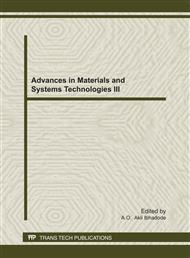[1]
Department of Environmental Road Research Laboratory, A Guide to the Structural Design for New Roads, Road note 29, third ed., Amazon, U. K, (1971).
Google Scholar
[2]
A.J. Hanks, E. R. Magni, The Use of Bituminous and Concrete Material in Granular Base And Earth. Materials Information Report MI-137, Engineering Materials Office, Ontario Ministry of Transportation, Downsview, Ontario. (1989).
Google Scholar
[3]
K.J. Osinubi, Stabilization of tropical black clay with cement and pulverized coal ash admixture, Advances in Unsaturated Geotechnics, ASCE Geotechnical Special Publication 99, C. D. Shackelford, S. L. Houston, and N. Y. Chang, eds, (2000).
DOI: 10.1061/40510(287)20
Google Scholar
[4]
K.J. Osinubi, T. S. Ijimdiya, I. Nmadu, Lime stabilization of black cotton soil using bagasse ash as admixture, Advanced Material Research, Trans Tech Publications, Switzerland, (2009), 62 – 64, 3-10.
DOI: 10.4028/www.scientific.net/amr.62-64.3
Google Scholar
[5]
R.L. Schroeder, The use of recycled materials in highway construction, U.S. Federal Highway Administration, 58(2), Washington, D.C. (1994).
Google Scholar
[6]
B. Scott, Demonstration of Lignite Fly Ash for Stabilizing Soil Surfaces, Progress Report, Carrington Research Extension Centre, North Dakota State University. (2006).
Google Scholar
[7]
P. Kolhe, Use of Cemented Material as Pavement Base or Sub-base. http: /kolhe. pravin. iitk. googlepages. com/thesis, (2008).
Google Scholar
[8]
R. Jeff, P.E. Miles, Guidelines for Use of RAP, Materials Operational Memorandum, No. 13, November (2006).
Google Scholar
[9]
Federal Highway Administration, User Guidelines for By-products and Secondary Use Materials in Pavement Construction, http: /www. rmrc. unh. edu/tools/uguideline/rap133. asp. pdf, (2008).
Google Scholar
[10]
F.C. Tyrion, Asphalt oxidation, Asphaltenes and Asphalts, Development in Petroleum Science, 40B, Elsevier, NY. (2000).
Google Scholar
[11]
R. Karlsson, U. Isaacsson, Material-related aspects of asphalt recycling - state of the art, Journal of Materials in Civil Engineering, American Society of Civil Engineers, 18(1), (2006), 81-92.
DOI: 10.1061/(asce)0899-1561(2006)18:1(81)
Google Scholar
[12]
D.S. Decker, T.J. Young, Handling RAP in an HMA facility. Proceedings of the Canadian Technical Asphalt Association, Edmonton, Alberta, (1996).
Google Scholar
[13]
S.A. Senior, S.I. Szoke, C.A. Rogers, Ontario experience with reclaimed materials for use in aggregate, Presented at the International Road Federation Conference, Calgary, Alberta. (1994).
Google Scholar
[14]
J.H. Charman, Laterite in road pavemen, Transportation and Road Research Laboratory, CIRIA Special Publication 47, Westminster, London 1988).
Google Scholar
[15]
M. Bwalya, Utilization and improvement of lateric gravels in road bases, International Institute for Aerospace Survey and Earth Sciences (ITC), Engineering Geology, Kanaalweg 3, 2628 EB, Delft, the Netherlands. (2006).
Google Scholar
[16]
S.H. Chew, A.H.M. Kamruzzaman, F.H. Lee, Physicochemical and engineering behavior of cement treated clays, Journal of Geotechnical and Geoenvironmental Engineering, 130(7), (2004), 696 – 706.
DOI: 10.1061/(asce)1090-0241(2004)130:7(696)
Google Scholar
[17]
BS 1377, Methods of Testing Soils for Civil Engineering Purposes, Technical Information Services Department, CNL Technical Information Services, BSI Publications, 389 Chiswick High Road London W4 4AL, (1990).
Google Scholar
[18]
Federal Ministry of Works and Housings, Nigerian General Specification for Roads and Bridges, Abuja, Nigeria, (1997).
Google Scholar
[19]
R.F. Craig, Soil Mechanics, fifth Ed., Chapman and Hall, London, (1992), pp.27-33.
Google Scholar
[20]
M.B. Das, Principles of Geotechnical Engineering. fourth Ed., PWS Publishing Company, Boston, USA, (1998).
Google Scholar
[21]
J. Locat, H. Tremblay, S. Leroueil, Mechanical and hydraulic behavior of a soft inorganic clay treated with lime, Can Geotech. J., 33, (1996), 654 – 565.
DOI: 10.1139/t96-090-311
Google Scholar
[22]
D.O.A. Osula, Evaluation of admixture stabilization for problem laterite, J. of Transportation Engineering, 115(6), (1989), 674 – 687.
DOI: 10.1061/(asce)0733-947x(1989)115:6(674)
Google Scholar
[23]
K.J. Osinubi, Influence of compaction delay on the properties of cement stabilized lateritic soil. J. of Engineering Research, 6(1), (1998), 13 – 25.
Google Scholar
[24]
S. Brunauer, J. Skalny, I. Odler, M. Yudenfreund, Hardened portland cement pastes of low porosity. VII further remarks about early hydration composition and surface area of tobermorite gel, Summary, Cement and Concrete Research, 3(3): (1973).
DOI: 10.1016/0008-8846(73)90031-8
Google Scholar


